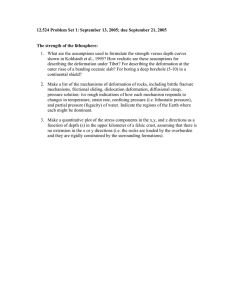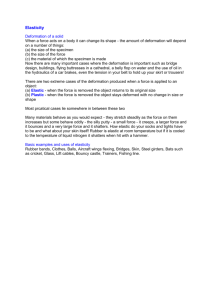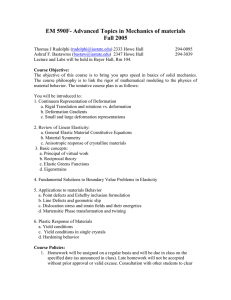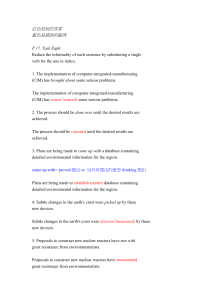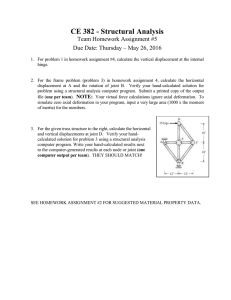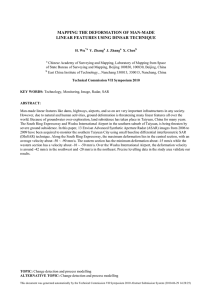In the notes on the ... ( ), we have left the ...
advertisement
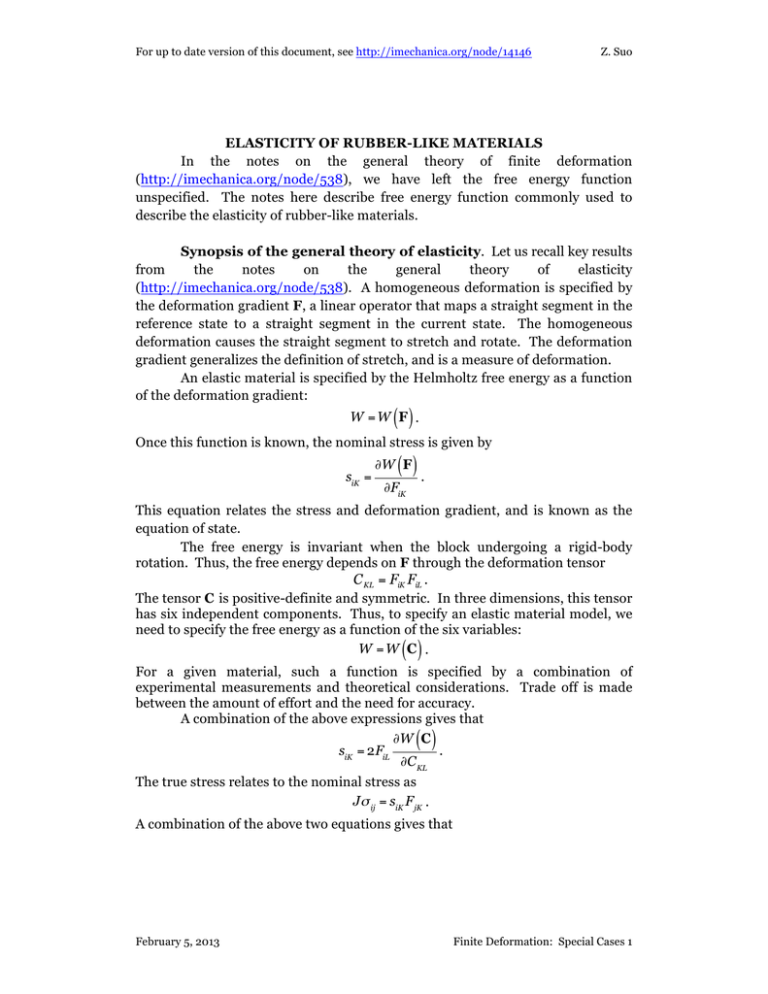
For up to date version of this document, see http://imechanica.org/node/14146 Z. Suo ELASTICITY OF RUBBER-LIKE MATERIALS In the notes on the general theory of finite deformation (http://imechanica.org/node/538), we have left the free energy function unspecified. The notes here describe free energy function commonly used to describe the elasticity of rubber-like materials. Synopsis of the general theory of elasticity. Let us recall key results from the notes on the general theory of elasticity (http://imechanica.org/node/538). A homogeneous deformation is specified by the deformation gradient F, a linear operator that maps a straight segment in the reference state to a straight segment in the current state. The homogeneous deformation causes the straight segment to stretch and rotate. The deformation gradient generalizes the definition of stretch, and is a measure of deformation. An elastic material is specified by the Helmholtz free energy as a function of the deformation gradient: ( ) W =W F . Once this function is known, the nominal stress is given by siK = ( ). ∂W F ∂FiK This equation relates the stress and deformation gradient, and is known as the equation of state. The free energy is invariant when the block undergoing a rigid-body rotation. Thus, the free energy depends on F through the deformation tensor C KL = FiK FiL . The tensor C is positive-definite and symmetric. In three dimensions, this tensor has six independent components. Thus, to specify an elastic material model, we need to specify the free energy as a function of the six variables: W =W C . ( ) For a given material, such a function is specified by a combination of experimental measurements and theoretical considerations. Trade off is made between the amount of effort and the need for accuracy. A combination of the above expressions gives that ∂W C . siK = 2FiL ∂C KL ( ) The true stress relates to the nominal stress as Jσ ij = siK F jK . A combination of the above two equations gives that February 5, 2013 Finite Deformation: Special Cases 1 For up to date version of this document, see http://imechanica.org/node/14146 σ ij = 2FiL F jK Z. Suo ( ). ∂W C ∂C KL The true stress is symmetric, σ ij = σ ji . Isotropy. For an isotropic material, the free-energy density is unchanged when the coordinates rotate in the reference state. When the coordinates rotate, however, the individual components of the tensor C will change. How do we write the function W (C ) for an isotropic material? For any symmetric second-rank tensor C, the six components of the tensor form three scalars: α = C KK , β = C KLC KL , γ = C KLC LJ C JK . These scalars are formed by combining the individual components of the tensor in ways that make all indices dummy. The three scalars remain unchanged when the coordinates rotate, and are known as the invariants of the tensor C. To specify model of an isotropic elastic material, we need to prescribe the free-energy density as a function of the three invariants of the Green deformation tensor: W = f (α , β , γ ) . Once this function is specified, we can derive the stress by using the chain rule: siK = ∂W (F ) ∂f ∂α ∂f ∂β ∂f ∂γ . = + + ∂FiK ∂α ∂FiK ∂β ∂FiK ∂γ ∂FiK Derivatives of this kind are recorded in many textbooks on continuum mechanics. Exercise. Invariants of a symmetric second-rank tensor can be written in many forms. In many textbooks, the invariants are introduced by using the characteristic equations. Relate invariants introduced by the characteristic equations and those written above. Incompressibility. Subject to external forces, elastomers can undergo large change in shape, but very small change in volume. A commonly used idealization is to assume that such materials are incompressible, namely, det F = 1 . In arriving at the relation siK = ∂W (F )/ ∂FiK , we have assumed that each component of FiK can vary independently. However, the condition of February 5, 2013 Finite Deformation: Special Cases 2 For up to date version of this document, see http://imechanica.org/node/14146 Z. Suo incompressibility places a constraint among the components. To enforce this constraint, we replace the free-energy function W (F ) by a function W (F ) − Π(det F − 1) , with Π as a Lagrange multiplier. We then allow each component of FiK to vary independently, and obtain the stress from ∂ [W (F ) − Π (det F − 1)]. siK = ∂FiK Recall an identity in the calculus of matrix: ∂ det F = H iK det F , ∂FiK where H is defined by H iK FiL = δ KL and H iK F jK = δ ij . For a proof see p. 41 of Holzapfel. Thus, for an incompressible material, the stress relates to the deformation gradient as ∂W (F ) siK = − ΠH iK . ∂FiK This equation, along with the constraint det F = 1 , specifies a material model for incompressible elastic materials. The Lagrange multiplier Π is not a material parameter. Rather, Π is to be solved as a field for a given boundary-value problem. When the deformation of the body is inhomogeneous, Π is in general also inhomogeneous. In terms of the true stress, the equation of state is σ ij = F jK ( ) − Πδ ∂W F ij ∂FiK . The Lagrange multiplier acts like a hydrostatic pressure. Arruda-Boyce eight-chain model. Next we consider a network of polymers, crosslinked by covalent bonds. Many models exist in the literature to derive the behavior of the network from that of the individual polymers. In the Arruda and Boyce model, the network is represented by many cells, each cell by a rectangle, and the polymers in the cell by the eight half diagonals. When the network is unstressed, the cell is a unit cube, and the length of a half diagonal is 3 / 2 . When the network is stretched, the cell is a rectangle with sides λ1 , λ2 ( and λ3 , and the length of a half diagonal is λ21 + λ22 + λ23 end-to-end length of each chain is February 5, 2013 1/2 ) /2. Consequently, the Finite Deformation: Special Cases 3 For up to date version of this document, see http://imechanica.org/node/14146 Λ= Z. Suo 1 2 2 (λ1 + λ2 + λ23 )1/2 . 3 Let v be the volume per link, and nv be the volume per chain. The free energy per unit volume of the network is w(Λ ) . W= nv The eight-chain model is described by a free energy function of the form W (Λ ). • E.M. Arruda and M.C. Boyce, A three dimensional constitutive model for the large stretch behavior of rubber elastic materials. Journal of the Mechanics and Physics of Solids 41, 389-412 (1993). Neo-Hookean material. free-energy function: A neo-Hookean material is defined by the µ F F −3 . 2 iK iK Note that C KK = FiK FiK is an invariant of the Green deformation tensor C. The material is also taken to be incompressible, namely, det F = 1 . The stress relates to the deformation gradient as siK = µFiK − ΠH iK . W= ( ) Exercise. In the notes on special cases of finite deformation (http://imechanica.org/node/5065), several forms of free energy function are given in terms of the principal stretches. They can be rewritten in terms of deformation gradient, following the same procedure outlined above. Go through this procedure for the Gent model. Multiaxial stress. We next explore states of multiaxial stress. Of course, the only way to really know stress-strain relations is to run tests, but tests alone would be too time-consuming and quickly become impractical. We’ll have to reduce the number of tests by some approximations. The art of making such compromise between accuracy and labor is known as formulating constitutive models. As an example, here we begin to describe this art for rubbers. Hyperelastic materials. We can represent a material particle by a rectangular block cut in the orientation of the three principal stresses. Let the block be stretched in the three directions by λ1 , λ2 and λ3 , and the February 5, 2013 Finite Deformation: Special Cases 4 For up to date version of this document, see http://imechanica.org/node/14146 corresponding nominal stresses be s1 , s2 and s3 . ( Z. Suo The complete stress-strain ) ( ) ( ) relations involve three functions s1 λ1 , λ2 , λ3 , s2 λ1 , λ2 , λ3 and s3 λ1 , λ2 , λ3 . In general, we can run tests to determine these functions. However, as we indicated above, running test alone would be too time-consuming. Instead, we will formulate a constitutive model on the basis that, in equilibrium, the work done by the forces is all stored in the block as energy. Consider a rectangular block of a material, lengths L1 , L2 and L3 in a reference state. In a current state, the block is subject to forces P1 , P2 and P3 on its faces, and is deformed into a block of lengths l1 , l2 and l3 . When lengths in the current state change, each of the forces does work, respectively, P1δl1 , P2δl2 , P3δl3 . We assume that the sum of the work done by the external forces equals the change in the free energy. Let F be the Helmholtz free energy of the block in the current state. When the block and the forces are in a state of equilibrium, subject to a small variation of the sides of the block, the work done by the forces equals the change in the free energy: δF = P1δl1 + P2δl2 + P3δl3 . This condition of equilibrium holds for arbitrary and independent small variations δl1 , δl2 , δl3 . P3 P2 P1 L3 L1 P1 l3 L2 l1 P2 l2 P3 current state reference state Let W be nominal density of the free energy, namely, the free energy of the block in the current state divided by the volume of the block in the reference state, F . W= L1 L2 L3 Define the nominal stresses by s1 = February 5, 2013 P P1 P , s2 = 2 , s 3 = 3 . L2 L3 L3 L1 L1 L2 Finite Deformation: Special Cases 5 For up to date version of this document, see http://imechanica.org/node/14146 Z. Suo Define the stretches by λ1 = l l1 l , λ2 = 2 , λ3 = 3 . L1 L2 L3 Dividing the condition of equilibrium by the volume of the block in the reference state, L1 L2 L3 , and recalling the definitions of nominal stress and stretch, we obtain that δW = s1δλ1 + s2δλ2 + s3δλ3 . This condition of equilibrium holds for arbitrary and independent variations δλ1 ,δλ2 ,δλ3 . As a material model, we assume that the free-energy density is a function of the three stretches: W = W λ1 , λ2 , λ3 . ( ) According calculus, ∂W (λ1 , λ2 , λ3 ) ∂W (λ1 , λ2 , λ3 ) ∂W (λ1 , λ2 , λ3 ) δW = δλ1 + δλ2 + δλ3 . ∂λ1 ∂λ2 ∂λ3 A comparison of the two expressions for δW , we obtain that ⎡ ∂W (λ1 , λ2 , λ3 )⎤ ∂W (λ1 , λ2 , λ3 )⎤ ∂W (λ1 , λ2 , λ3 )⎤ ⎡ ⎡ ⎥δλ3 = 0 ⎢s1 − ⎥δλ1 + ⎢s2 − ⎥δλ2 + ⎢s3 − ∂λ1 ∂λ2 ∂λ3 ⎢⎣ ⎥⎦ ⎣ ⎦ ⎣ ⎦ This condition of equilibrium holds for arbitrary and independent variations δλ1 ,δλ2 ,δλ3 . Consequently, the stresses equal the partial derivatives: s1 = ∂W (λ1 , λ2 , λ3 ) ∂W (λ1 , λ2 , λ3 ) ∂W (λ1 , λ2 , λ3 ) . , s2 = , s3 = ∂λ1 ∂λ2 ∂λ3 An elastic material whose stress-strain relation is derivable from a freeenergy function is known as a hyperelastic material. By contrast, an elastic material whose stress-strain relation is not derivable from a free-energy function is called a hypoelastic material. The nominal stress on one face is P s1 = 1 . L2 L3 The true stress on the same face is σ1 = P1 . l2l3 Consequently, the true stress relates to the nominal stress by s σ1 = 1 . λ2λ3 February 5, 2013 Finite Deformation: Special Cases 6 For up to date version of this document, see http://imechanica.org/node/14146 Z. Suo The true stress is derivable from the strain-energy function: ∂W (λ1 , λ2 , λ3 ) . σ1 = λ2λ3∂λ1 The other two components of true stress can be similarly obtained. Note that the true stress is not work-conjugate to the stretch. Incompressible, isotropic, hyperelastic material. When a material undergoes large deformation, the amount of volumetric deformation is often small compared to the overall deformation. Consequently, we may neglect the volumetric deformation, and assume that the material is incompressible. A block of a material, of lengths L1 , L2 and L3 in the undeformed state, is deformed into a rectangle of lengths l1 , l2 and l3 . If the material is incompressible, the volume of the block must remain unchanged, namely, L1 L2 L3 = l1l2l3 , or λ1λ2λ3 = 1 . The incompressibility places a constraint among the three stretches: they cannot vary independently. We may regard λ1 and λ2 as independent variables, so that −1 λ3 = (λ1 λ2 ) . −1 Taking differential of the constraint λ3 = (λ1 λ2 ) , we obtain that δλ3 = λ1−2λ2−1δλ1 + λ1−1 λ2−2δλ2 . Inserting the assumption of incompressibility into the condition of equilibrium, δW = s1δλ1 + s2δλ2 + s3δλ3 , we obtain that δW = (s1 − λ1−2λ2−1 s3 )δλ1 + (s2 − λ2−2λ1−1 s3 )δλ2 . This condition of equilibrium holds for arbitrary and independent variations δλ1 and δλ2 . As a material model, we assume that the free-energy density is a function of the two stretches: W = W (λ1 , λ2 ) . According calculus, δW = ∂W (λ1 , λ2 ) ∂W (λ1 , λ2 ) δλ1 + δλ2 . ∂λ1 ∂λ2 A comparison of the two expressions for δW , we obtain that ⎡ ⎡ ∂W (λ1 , λ2 )⎤ ∂W (λ1 , λ2 )⎤ −2 −1 −2 −1 ⎢s1 − λ1 λ2 s3 − ⎥δλ1 + ⎢s2 − λ2 λ1 s3 − ⎥δλ2 = 0 ∂λ1 ∂λ2 ⎣ ⎦ ⎣ ⎦ February 5, 2013 Finite Deformation: Special Cases 7 For up to date version of this document, see http://imechanica.org/node/14146 Z. Suo This condition of equilibrium holds for arbitrary and independent variations δλ1 , δλ2 . Consequently, once the function W (λ1 , λ2 ) is determined, the stressstretch relation is given by differentiation: s1 − λ1−2 λ2−1 s3 = ∂W (λ1 , λ2 ) , ∂λ1 s2 − λ2−2 λ1−1 s3 = ∂W (λ1 , λ2 ) . ∂λ2 These relations, together with the incompressibility condition λ1λ2λ3 = 1 , replace Hooke’s law and serve as the stress-strain relations for incompressible, isotropic and hyperelastic materials. For incompressible materials, the true stresses relate to the nominal stresses as σ 1 = λ1s1 , σ 2 = λ2s2 , σ 3 = λ3s3 . Consequently, the stress-strain relations become ∂W (λ1 , λ2 ) , σ 1 − σ 3 = λ1 ∂λ1 σ 2 − σ 3 = λ2 ∂W (λ1 , λ2 ) . ∂λ2 Because the material is incompressible, once the stretches are known, the material model leaves the hydrostatic stress undetermined. The function W (λ1 , λ2 ) can be determined by subjecting a sheet of a rubber under various states of biaxial stress. The form of the function is sometimes inspired by theoretical considerations. Here are some often used forms. Neo-Hookean model. This model is specified by the energy-density function: W= µ (λ 2 2 1 + λ22 + λ23 − 3) . The material is also taken to be incompressible, λ1 λ2λ3 = 1 . Recall that σ 1 − σ 3 = λ1 ∂W (λ1 , λ2 ) . ∂λ1 −1 Inserting the constraint λ3 = (λ1 λ2 ) , we obtain the stress-stretch relation: σ 1 − σ 3 = µ (λ21 − λ23 ). February 5, 2013 Finite Deformation: Special Cases 8 For up to date version of this document, see http://imechanica.org/node/14146 Z. Suo Similarly, we obtain that σ 2 − σ 3 = µ (λ22 − λ23 ). A neo-Hookean material is characterized by a single elastic constant, µ . The constant may be determined experimentally. For example, consider a bar in a state of uniaxial stress: σ 1 = σ , σ 2 = σ 3 = 0. Let the stretch along the axis of loading be λ1 = λ . Incompressibility dictates that the stretches in the directions transverse to the loading axis be λ2 = λ3 = λ−1 / 2 . Inserting into the above stress-stretch relation, we obtain the relation under the uniaxial stress: σ = µ (λ2 − λ−1 ). Recall that stretch relates to the engineering strain as λ = l/L =1+e. When the strain is small, namely, e << 1 , the above stress-stretch relation reduces to σ = 3µe . Thus, we interpret 3µ as Young’s modulus and µ the shear modulus. The form of strain-energy function of Neo-Hookean materials has also emerged from a model in statistical mechanics. The model gives µ = NkT , where N is the number of polymer chains per unit volume, and kT the temperature in units of energy. • L.R.G. Treloar, The Physics of Rubber Elasticity, Third Edition, Oxford University Press, 1975. Gent model. In an elastomer, each individual polymer chain has a finite contour length. When the elastomer is subject no loads, the polymer chains are coiled, allowing a large number of conformations. Subject to loads, the polymer chains become less coiled. As the loads increase, the end-to-end distance of each polymer chain approaches the finite contour length, and the elastomer approaches a limiting stretch. On approaching the limiting stretch, the elastomer stiffens steeply. This effect is absent in the neo-Hookean model, but is represented by the Gent model: ⎛ λ2 + λ22 + λ23 − 3 ⎞ ⎟ . log⎜⎜ 1 − 1 ⎟ 2 J lim ⎝ ⎠ where µ is the small-stress shear modulus, and J lim is a constant related to the W =− February 5, 2013 µJ lim Finite Deformation: Special Cases 9 For up to date version of this document, see http://imechanica.org/node/14146 ( ( 2 2 ) The stretches are restricted as 0 ≤ λ21 + λ22 + λ23 − 3 / J lim < 1 . limiting stretch. 2 1 Z. Suo 2 3 ) When λ + λ + λ − 3 / J lim → 0 , the Taylor expansion of the Gent model recovers ( ) the neo-Hookean mode. When λ21 + λ22 + λ23 − 3 / J lim → 1 , the free energy diverges, and the elastomer approaches the limiting stretch. The material is also taken to be incompressible. relations are σ1 −σ3 = 1− σ2 −σ3 = 1− • The stress-stretch µ (λ21 − λ23 ) , λ21 + λ22 + λ23 − 3 J lim µ (λ22 − λ23 ) . λ21 + λ22 + λ23 − 3 J lim Gent, A. N., A new constitutive relation for rubber. Rubber Chemistry and Technology, 1996, 69: 59-61. Model a polymer as a freely-jointed chain. First consider an individual polymer. Let Λ be the stretch of the polymer, namely, the end-to-end length of the stretched polymer r divided by that of the released polymer r0 , namely, r Λ= r0 The Helmholtz free energy of the polymer, w, is a function of the stretch, namely, w = w(Λ ) . Consider the model of freely-jointed chain of Kuhn and Grun. In this model, a polymer chain is modeled by a sequence of links capable of free rotation relative to each other. At a finite temperature, the relative rotations of the links allow the polymer chain to fluctuate among a large number of conformations. The statistics of the conformations gives the force-stretch behavior of the polymer chain ⎛ 1 1 ⎞ Λ = n ⎜⎜ − ⎟⎟ ⎝ tanh ζ ζ ⎠ where n is the number of links per polymer chain, and ζ the normalized force in the polymer chain. The Helmholtz free energy of the polymer is ⎛ ζ ζ w = nkT ⎜⎜ − 1 + log sinh ζ ⎝ tanh ζ February 5, 2013 ⎞ ⎟⎟ ⎠ Finite Deformation: Special Cases 10 For up to date version of this document, see http://imechanica.org/node/14146 Z. Suo where kT is the temperature in the unit of energy. • W. Kuhn and F. Grun, Kolloidzschr. 101, 248 (1942). • L.R.G. Treloar, The Physics of Rubber Elasticity, Third Edition, Oxford University Press, 1975. Next we represent each chain by using the freely-jointed chain model. The Helmholtz free energy per unit volume of the elastomer is kT v ⎛ ζ ζ ⎞ ⎜⎜ ⎟ − 1 + log sinh ζ ⎟⎠ ⎝ tanh ζ These Equations defines the function W (λ1 , λ2 ) using two intermediate W= parameters: the stretch Λ in each chain and the normalized force ζ in each chain. In one limit, ζ → ∞ , the chain approaches the limiting stretch, Λ → n . In the other limit, ζ → 0 , the chain coils much below the limiting stretch, Λ << n , and the model reduces to W = (kT / 6v)ζ 2 and Λ = ( n / 3)ζ , which recovers the neo-Hookean model, with the small-strain shear modulus µ = kT /(vn ) . The material is also taken to be incompressible, λ1 λ2λ3 = 1 . Recall that σ 1 − σ 3 = λ1 ∂W (λ1 , λ2 ) . ∂λ1 According to calculus, we write −1 dW (ζ ) ⎛ dΛ(ζ ) ⎞ ∂Λ(λ1 , λ2 ) . ⎜ ⎟ σ 1 − σ 3 = λ1 dζ ⎜⎝ dζ ⎟⎠ ∂λ1 A direct calculation gives that kTζ (λ21 − λ23 ) . σ1 −σ3 = 3v n Λ We can similarly obtain that kTζ (λ22 − λ23 ) . σ2 −σ3 = 3v n Λ Like the Gent model, the model of freely-joined chain can also capture the extension limit. Mooney model. In this model, the free energy is fit to the expression W = c1 (λ21 + λ22 + λ23 − 3)+ c2 (λ1−2 + λ2−2 + λ−32 − 3). • M. Mooney (1940) A theory of large elastic deformation, Journal of February 5, 2013 Finite Deformation: Special Cases 11 For up to date version of this document, see http://imechanica.org/node/14146 Z. Suo Applied Physics 11, 582-592. Ogden model. In this model, the free energy density is fit to a series of more terms W= µ ∑ α (λ n 1 n where αn ) + λα2 + λα3 − 3 , n n n α n may have any values, positive or negative, and are not necessarily integers, and µ n are constants. The stress-stretch relations are σ 1 − σ 3 = ∑ µn (λα1 − λα3 ), n n n σ 2 − σ 3 = ∑ µn (λα2 − λα3 ). n n n • R.W. Odgen (1972) Large deformation isotropic elasticity – on the correlation of theory and experiment for incompressible rubberlike solids. Proceedings of the Royal Society of London A326, 567-583. Reading. Erwan Verron (http://imechanica.org/node/4167), bibliography of the literature on the mechanics of rubbers up to 2003. February 5, 2013 a Finite Deformation: Special Cases 12
